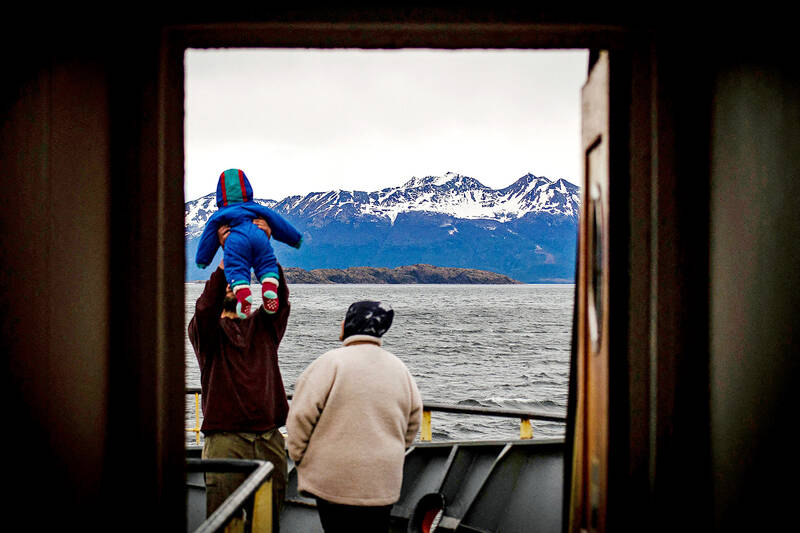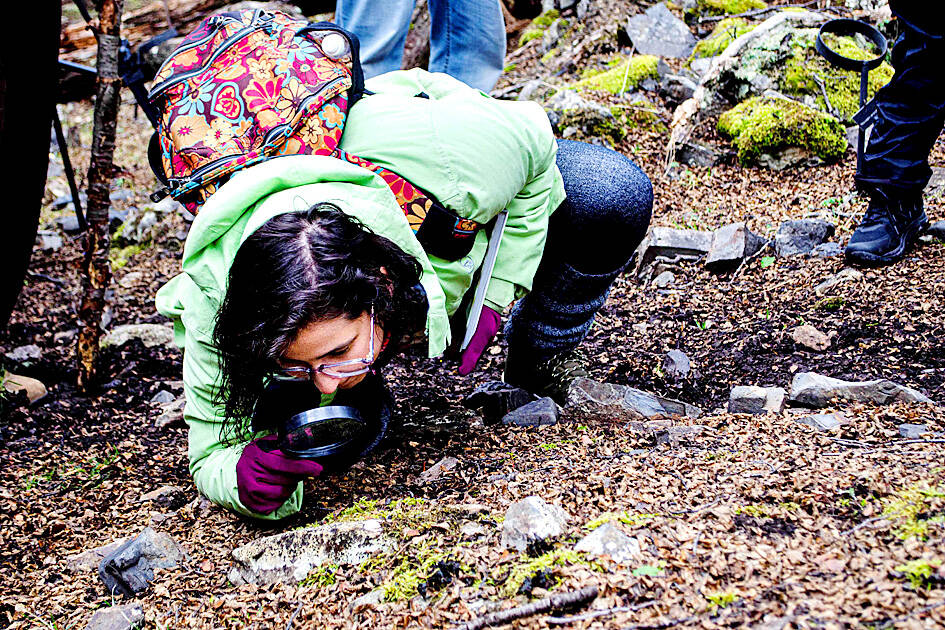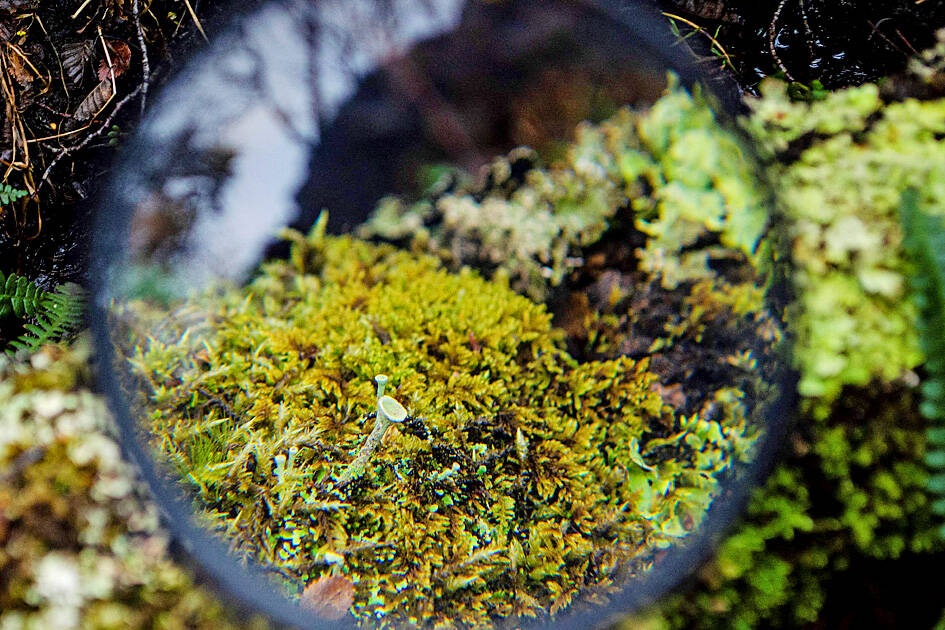Hidden inside pristine forests in Chile’s deep south, known as the end of the world, lie potential early warning signs of climate change.
Puerto Williams on Navarino Island, which is separated from the South American mainland by the Beagle Channel, is the world’s southern-most town.
Far from the pollution that blights major urban and industrial centers, it is a paradise that provides unique conditions to study global warming.

Photo: AFP
“There is nowhere else like it,” said Ricardo Rozzi, director of the Cape Horn International Center for global change studies and biocultural conservation in Puerto Williams.
It is “a place that is especially sensitive to climate change” as average temperatures do not rise above five degrees Celsius.
This cold and windy area is the last inhabited southern frontier before reaching Antarctica.

Photo: AFP
The Omora Ethnobotanical Park is home to an immense variety of lichens, mosses and fungi that scientists study by crouching down onto their knees with magnifying glasses.
In the crystal clear Robalo river, minuscule organisms act as sentinels of the changes produced by global warming.
In both the park and river, the alarm bells are ringing.

Photo: AFP
At this latitude — 55° south — climate change has an exponential effect on flora that react by seeking out low temperatures, Rozzi, 61, said.
“The most obvious aspect of climate change is the rising temperatures,” he said.
“These lichens cannot survive” if a certain threshold is passed, and to escape the higher temperatures, they move, he said.
“In the case of [mosses], we’ve noticed that they have moved. Before they were between 50 and 350 [meters above sea level] and now they are between 100 and 400,” he said.
Rozzi says that Omora has more diversity per square meter of lichens and mosses than anywhere else in the world.
They also help to absorb carbon dioxide.
Another aspect is the elevational diversity gradient, an ecological pattern in which biodiversity changes with elevation.
The 700m high Bandera hill’s biodiversity changes every 200m and there is a 1.5°C difference in temperature between top and bottom.
“We can see what changes happen in the high mountains and in the area close to the sea in a very short distance, and we can see how the temperature affects the biodiversity that lives in this river,” said Tamara Contador, 38, a biologist at the Cape Horn International Center.
She studies the gradients themselves.
If the height difference between gradients rises or falls on the mountain, scientists can determine whether there has been a global change in temperature.
They say there has been.
“On a global level, the polar and subpolar ecosystems are the most affected by climate change, so we are in a place where climate change has a much bigger effect on biodiversity than other places,” Contador said.
River organisms also form part of the alert system.
“The organisms that live here are also indicators of water quality and global environmental change,” Contador added.
River organisms move about and have already increased their reproductive cycle, Rozzi said.
That confirms there has been a small change to the climate in the area that could have been much greater elsewhere on the planet.
“Some insects that have an annual eggs to larvae to adulthood cycle are now having two cycles because the temperature has risen,” Rozzi said.
By studying these organisms and learning from them “we can avoid crossing the threshold that brings us to the extermination of humanity and other life forms,” he added.

Australia has announced an agreement with the tiny Pacific nation Nauru enabling it to send hundreds of immigrants to the barren island. The deal affects more than 220 immigrants in Australia, including some convicted of serious crimes. Australian Minister of Home Affairs Tony Burke signed the memorandum of understanding on a visit to Nauru, the government said in a statement on Friday. “It contains undertakings for the proper treatment and long-term residence of people who have no legal right to stay in Australia, to be received in Nauru,” it said. “Australia will provide funding to underpin this arrangement and support Nauru’s long-term economic

ANGER: Unrest worsened after a taxi driver was killed by a police vehicle on Thursday, as protesters set alight government buildings across the nation Protests worsened overnight across major cities of Indonesia, far beyond the capital, Jakarta, as demonstrators defied Indonesian President Prabowo Subianto’s call for calm. The most serious unrest was seen in the eastern city of Makassar, while protests also unfolded in Bandung, Surabaya, Solo and Yogyakarta. By yesterday morning, crowds had dispersed in Jakarta. Troops patrolled the streets with tactical vehicles and helped civilians clear trash, although smoke was still rising in various protest sites. Three people died and five were injured in Makassar when protesters set fire to the regional parliament building during a plenary session on Friday evening, according to

‘NEO-NAZIS’: A minister described the rally as ‘spreading hate’ and ‘dividing our communities,’ adding that it had been organized and promoted by far-right groups Thousands of Australians joined anti-immigration rallies across the country yesterday that the center-left government condemned, saying they sought to spread hate and were linked to neo-Nazis. “March for Australia” rallies against immigration were held in Sydney, and other state capitals and regional centers, according to the group’s Web site. “Mass migration has torn at the bonds that held our communities together,” the Web site said. The group posted on X on Saturday that the rallies aimed to do “what the mainstream politicians never have the courage to do: demand an end to mass immigration.” The group also said it was concerned about culture,

CRACKDOWN: The Indonesian president vowed to clamp down on ‘treason and terrorism,’ while acceding to some protest demands to revoke lawmaker benefits Protests in Indonesia over rising living costs and inequality intensified overnight, prompting Indonesian President Prabowo Subianto to cancel a planned trip to China, while demonstrators reportedly targeted the homes of the finance minister and several lawmakers. Rioters entered Indonesian Minister of Finance Sri Mulyani Indrawati’s residence near Jakarta early yesterday, but were repelled by armed forces personnel, Kompas reported. Items were taken from the homes of lawmaker Ahmad Sahroni and two others, according to Detik.com. The reports of looting could not be independently verified, and the finance ministry has not responded to requests for comment. The protests were sparked by outrage over